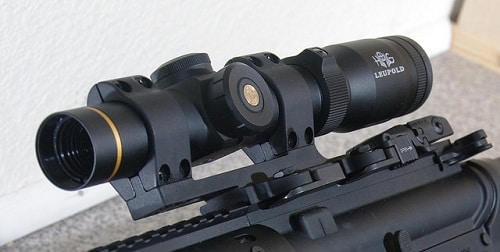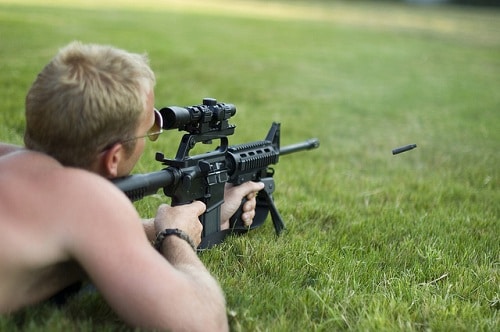The scopes of today’s era rifles adjust to point-of-impact specifications, which is a huge plus for hunters and shooters because accuracy in long-distance shooting is improved tremendously. The scope has knobs on the top and bottom, both of which have significantly help to zero in your shot. Old timers like me learned to adjust a scope on Civil War-era weapons. Nowadays, it is much easier, but it still takes practice and precision. When learning how to adjust a rifle scope, just follow these steps and mix in a bit of personal comfort based on your weapon.
Getting Set Up
The first step to learning how to adjust a rifle scope is to have the correct tools.
Ensure that the scope is properly fixed to the barrel, and that you have a trusted rest in place.
Equally important is identifying the ammo you’ll use. The ammo that you adjust the scope with should be the SAME ammo you’re using in the field.
Here are the first steps:
- Move the crosshairs. Based on the shooter’s ability to the bore, you’ll want to move the crosshairs so that they are in line with where he or she is at.
- Zero the rifle at short distance. The first real step here is to align the barrel and scope. If you know your rifle, doing this is by bore sighting is doable. Place your rifle in a firm rest, and make sure the action is open. Set up a target that isn’t too far out (less than thirty yards) and preferable with some sort of a central mark or perfect shot marker on it. This allows you to align the barrel of your gun with the mark.
- Note the erector tube. You don’t want the target image to appear upside down when viewed through the scope. This is the purpose of the erector tube. It will contain multiple lenses that adjust the image back and forth within the scope, ultimately presenting it as is. Don’t tighten the rings too much or else the erector tube won’t be as mobile inside the scope as it should be.
Fire Some Test Shots
This is how you’ll test your bore sighting skills. How close was the shot? Don’t worry if it was not even close, especially if this is your first time adjusting the scope on this gun. Make small movements to the scope to get that zero dialed in. Remember that a zero at 25 yards typically goes high at 100 yards, so if 100 yards is the target distance, adjust the scope to be about one inch lower than the zero at 25 yards.
- Make small tweaks as necessary. If you’ve got the scope adjusted perfectly after less than five shots, you must know your rifle pretty well. When I’m working a new gun, I typically allow up to ten shots just so I can get a feel for the give and take.
- Take windage into consideration. Are you shooting at a range, or out in the field? If out in the field, how well do you know the area, and more specifically, how your gun shoots in that climate?
- Check the mounting. If you have continued problems getting the scope to zero and/or to a point of comfortability, it may be a result of sloppy mounting. I’ve had to take off and re-mount the scope on new rifles more than once, which taught me real quick that no two guns are exactly the same. Keep this in mind, and if you remember, double check the mounting before firing test shots.
Use Modern Guns And Scopes
This sounds like a picky thing to say, but as I said above, I grew up adjusting really old scopes and rifles. Today’s technology is so much better than what I grew up on, there isn’t any reason to not use the latest stuff available. Unless, of course, you’re a historian or antique gun fanatic! The scopes on modern guns have two adjustable knobs that make the process both easy and fun.
Variable scopes allow for less adjustment than fixed-power scopes, as a result of an extra cam tube. Referring to the erector tube, don’t force down on the variable scope at all while adjusting for risk of restricting it’s functions. If you have an Ar10, so you can find the best scope for an AR-10 to have the good shoot
Things To Consider When Choosing A Rifle Scope
Knowing how to adjust a rifle scope is fine, but your first priority is to make sure you have the right one. When you first get a scope, it might seem like the perfect fit. However, you’ll soon learn that the wrong equipment will give you trouble down the line. So before you find yourself readjusting on a regular basis, make sure you have the proper scope. Here are a few things to consider:
Get A Rifle Scope That Matches Your Needs
Rifle scopes are cool and I know you feel like a sniper in an action movie when you use it. However, getting the one with the most advanced features isn’t always the best choice. The most important thing is to find a scope that matches your rifle. Otherwise, it won’t operate properly—what good would that do you?
Read Reviews
No matter how fascinating the product description is on a rifle scope, the true test is its performance. Don’t get too eager and buy one before reading reviews. People tend to be brutally honest about their opinions on the items they’ve spent money on. Take some time weighing the pros and cons before making a decision.
Thoroughly Read Over All The Features
Some companies will hype up one feature and skimp on all the others. For instance, if a product description primarily focuses on magnification, that’s not good enough. The lens coating and optical quality really define whether a scope is worth it. Choose wisely.
The Difference Between Each Rifle Scope
I’m pretty sure you know what a rifle scope is used for. However, the more educated you are on them, the better.
Tactical Rifle Scope
A tactical scope generally has low magnification, and it’s used to extend the range of engagement. It moves the general 300 meters on an infantry rifle to 600 meters by using low magnification— without hindering the close-range capacity.
Hunting Rifle Scope
Most hunting scopes don’t have a lot of features and are relatively easy to use. They have to have a simple operation so they are more manageable in the woods. It’s common for hunting scopes to either be a power or fixed power, but they’ll usually have a bigger objective—it allows in more light for a clearer and brighter view.
Competition Rifle Scope
Large scopes are great for challenges and many are used to shoot in low powered .22 competitions—which require precise accuracy. If you have a 40x scope, it’s only useful in competitions. Otherwise, you can use one that’s less durable and has less light transition.
Final Thoughts On How To Adjust A Rifle Scope

From there, it’s all step and repeat. With each new scope, I recommend repeating this process to make sure that the scope is a) mounted correctly, and b) zeroed correctly.
Just like guns, scopes are all different. Gradually move your testing target further away as you get more comfortable with the scope.
Because this is so important, I ask that all readers who enjoyed this article take a moment to share it on social media or with family and friends that are avid shooters. Shooter should buy the best handgun safe for the money to keep family safe from your gun.
I’m all ears for tips that you’ve found for specific scopes, so feel free to leave a comment.
